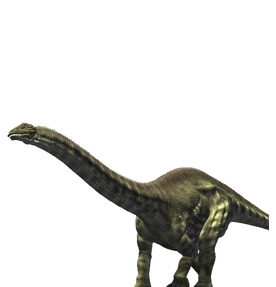
Brontosaurus (/ˌbrɒntɵˈsɔrəs/ bron-tə-SAWR-əs), meaning "thunder lizard" (from Greek βροντή, brontē = thunder + σαυρος, sauros = lizard), is a genus of sauropod dinosaurs. Originally named by its discoverer Othniel Charles Marsh in 1879, Brontosaurus had long been considered a junior synonym of Apatosaurus; its original species Brontosaurus excelsus having been reclassified as A. excelsus in 1903. However, an extensive study published in 2015 by a joint research team of England and Portugal concluded that Brontosaurus was a valid genus of sauropod distinct from Apatosaurus. Nevertheless, not all paleontologists agree with this division.
The same study classified two additional species that had once been considered Apatosaurus as Brontosaurus parvus and Brontosaurus yahnahpin. Species of Brontosaurus range in age from 155 to 152 million years ago, during the Kimmeridgian age of the lower to middle Morrison Formation in Wyoming and Utah, USA.
As the archetypal sauropod, Brontosaurus is one of the best-known dinosaurs, and has been featured in film, advertising, and postal stamps, as well as many other types of media.
Description
Brontosaurus was a large, long-necked quadrupedal animal with a long, whip-like tail, and forelimbs that were slightly shorter than their hindlimbs. The largest species, B. excelsus, weighed up to 15 tonnes (15 long tons; 17 short tons) and measured up to 22 m (72 ft) long from head to tail.
The skull of Brontosaurus has not been found, but was probably similar to the skull of the closely related Apatosaurus. Like those of other sauropods, the vertebrae of the neck were deeply bifurcated; that is, they carried paired spines, resulting in a wide and deep neck. The vertebral formula was: 15 cervicals, 10 dorsals, five sacrals, and 82 caudals. The caudal vertebra number was noted to vary, even within a species. The cervical vertebrae were stouter than other diplodocids, though not as stout as in mature specimens of Apatosaurus. The dorsal ribs are not fused or tightly attached to their vertebrae, instead being loosely articulated. Ten dorsal ribs are on either side of the body. The large neck was filled with an extensive system of weight-saving air sacs. Brontosaurus, like its close relative Apatosaurus, had tall spines on its vertebrae, which make up more than half the height of the individual bones. The shape of the tail was unusual for diplodocids, being comparatively slender, due to the vertebral spines rapidly decreasing in height the farther they are from the hips. Brontosaurus also had very long ribs compared to most other diplodocids, giving them unusually deep chests. As in other diplodocids, the last portion of the tail of Brontosaurus possessed a whip-like structure.
The limb bones were also very robust. The arm bones are stout, with the humerus resembling that of Camarasaurus, and those of B. excelsus being nearly identical to those of Apatosaurus ajax. Charles Gilmore in 1936 noted that previous reconstructions erroneously proposed that the radius and ulna could cross, when in life they would have remained parallel. Brontosaurus had a single large claw on each forelimb, and the first three toes possessed claws on each foot. Even by 1936, it was recognized that no sauropod had more than one hand claw preserved, and this one claw is now accepted as the maximum number throughout the entire group. The single front claw bone is slightly curved, and squarely shortened on the front end. The hip bones included a robust ilia, and the fused pubes and ischia. The tibia and fibula bones of the lower leg were different from the slender bones of Diplodocus, but nearly indistinguishable from those of Camarasaurus. The fibula is longer than the tibia, although it is also more slender.